في عصر تعدد المهام، فإن كل حيل الإنتاجية التي تزيد من الكفاءة في العمل أمر بالغ الأهمية. لأسباب عديدة!
هل تجد نفسك تقوم بالتبديل بين المنصات لإكمال مهام مختلفة على مدار اليوم؟ هذا يسمى تبديل السياق.
يجب أن تتوسع الشركات، ويجب أن تكون الصحة العقلية للعاملين على رأس أولوياتهم. فلا مجال للوصول إلى نهاية يوم العمل وأنت تشعر بالإنتاجية والإرهاق الذهني دون أن تكون قد أنجزت أي مهام ذات أولوية. وهذه بالضبط إحدى عواقب التبديل بين السياقات التي تتسم بالجموح.
يعد تبديل السياق مشكلة مكلفة للمؤسسات. إنه أمر جوهري في مكان العمل الحديث ويقتل الإنتاجية. ولكن يمكنك الحد من تأثيره السلبي على الرفاهية وجودة نتائج العمل.
تابع معنا لتتعرف على ما يستلزمه تبديل المهام، وتكلفته، وما يمكنك فعله حيال ذلك.
ما هو تبديل السياق؟
التبديل في السياق هو التبديل المتتالي في الانتباه بين عدة مهام مختلفة غير مرتبطة ببعضها البعض طوال يوم العمل.
على سبيل المثال، أثناء إعداد مجموعة شرائح لعرض تقديمي، تتحقق أيضًا من رسائل البريد الإلكتروني. ثم تتحول إلى تحليل تقرير المبيعات الأسبوعي قبل أن تقاطع ذلك للرد على الرسائل الفورية. ويمكننا الاستمرار!
 يقول علماء معهد ماساتشوستس للتكنولوجيا
التبديل بين المهام هو لبنة أساسية في حياتنا اليومية. فالقدرة البشرية على التبديل بين المهام هائلة، وأدمغتنا موصولة بالمرونة الإدراكية.
يقول علماء معهد ماساتشوستس للتكنولوجيا
التبديل بين المهام هو لبنة أساسية في حياتنا اليومية. فالقدرة البشرية على التبديل بين المهام هائلة، وأدمغتنا موصولة بالمرونة الإدراكية.
وهذا يعني أننا قادرون على التبديل بين السياقات التي تنطبق عليها قواعد وخطط عمل مختلفة. وذلك لأننا بالفطرة نحتفظ بمعلومات عن سياق ما في أذهاننا أثناء وجودنا في سياق آخر.
ولسوء الحظ، فإن المرونة الإدراكية لها ثمن - "تكلفة التبديل" بالإضافة إلى أن التبديل بين السياقات جزء لا مفر منه في العمل المؤسسي.
ما هي تكلفة تبديل السياق؟
يمكن أن تختلف التكلفة الفعلية لتبديل السياق اعتمادًا على عوامل مثل نظام التشغيل المحدد، وبنية الأجهزة، وعدد العمليات التي يتم تبديلها. وقد قدمت دراسات وتجارب مختلفة تقديرات لتكاليف تبديل السياق تتراوح بين بضع ثوانٍ وعشرات الميكروثانية.
- وفقًا لمراجعة أدبية قام بهاستيفن مونسلفإن التبديل المتكرر بين المهام يضر بالأداء ويزيد من الأخطاء بعد كل تبديل مباشرة.
- إنأمريكي/href/ https://www.apa.org/topics/research/multitasking ف /%المرجع/جمعية علم الكلام (APA) لخصوا نتائج أبحاث متعددة حول تكلفة تبديل السياق. وأوضحوا أن الدماغ البشري (الذاكرة العاملة) لم يُصمم للتبديل المكثف للمهام. وهذا هو السبب في انخفاض الإنتاجية عند زيادة تبديل المهام، خاصةً في حالة التعقيد.
- ديفيد ماير أوضح أن العمال الذين يبدلون المهام باستمرار يفقدون تركيزهم لعشرات الدقائق فقط في كل مرة. ولكن نتيجة لذلك، تقل كفاءتهم بنسبة 20-40%.
- تظهر الأبحاث منكتالوج ومختبر إليس للأفكار التابع لجامعة كورنيل أن الموظفين
- يقضون 36 دقيقة في تبديل الأدوات والتطبيقات كل يوم
- يستغرقون، في المتوسط، تسع دقائق ونصف لإعادة التركيز
- يشعرون بالتعب بنسبة 43% أكثر
- أقل إنتاجية بنسبة 45%
بالتأكيد، ظاهرياً، قد لا تتنازل كثيراً عند التبديل بين المهام البسيطة. ولكن القيام بذلك طوال اليوم هو مستوى آخر تمامًا. واستعادة المزيد وقت التركيز والعمل العميق، تبحث الفرق دائمًا عن طرق لمكافحة التبديل بين السياقات حتى لا تبدو المهمة الواحدة وكأنها عبء آخر.
ومن المثير للاهتمام أن مطوري البرمجيات لا يشعرون بأنهم غير منتجين كلما قاموا بتبديل السياقات. دراسة أجراها أندريه ن. ماير ادعى أن هؤلاء المهنيين يقومون بتبديل المهام في المتوسط 13 مرة في الساعة. ومع ذلك، يرى المطورون أنفسهم أقل إنتاجية في بعض الظروف المحددة فقط. على سبيل المثال، مناقشة موضوع لا علاقة له بالموضوع مع زميل في الفريق لمدة نصف ساعة هي إحدى تلك الظروف.
ومن ناحية أخرى، فإن كتابة رسالة فورية أثناء انتظار اكتمال البناء لا يجعل المطورين يشعرون بأنهم أقل إنتاجية. في هذا السيناريو المحدد، يكون تركيزهم أقل على المهمة التي بين أيديهم عند بدء مهمة جديدة.
وأخيراً, صوفي لوروا أوضحت أن العمال يجب أن يتوقفوا عن التفكير في إحدى المهام ليتمكنوا من الأداء الجيد بعد الانتقال إلى مهمة أخرى. وخلصت الباحثة أيضًا إلى أن هذا السيناريو غير محتمل إذا كانت المهمة الأولى غير مكتملة ولا يوجد ضغط زمني لإنهائها أو المهمة التالية.
تبديل السياق مقابل تعدد المهام
التبديل بين السياق وتعدد المهام هما طريقتان مختلفتان لإدارة المهام المتعددة. ينطوي تبديل السياق على التبديل السريع بين المهام، وغالبًا ما يؤدي ذلك إلى مقاطعة تدفق العمل ويتطلب جهدًا ذهنيًا لإعادة التركيز. ويمكن أن يؤدي إلى انخفاض الإنتاجية وزيادة الأخطاء.
من ناحية أخرى، ينطوي تعدد المهام على التعامل مع مهام متعددة في وقت واحد. ويمكن القيام بذلك عن طريق تحديد أولويات المهام وتخصيص وقت لكل منها. في حين أن تعدد المهام يسمح بالتقدم المتوازي، إلا أنه يمكن أن يؤدي أيضًا إلى تشتت الانتباه وانخفاض الكفاءة. يعتمد الاختيار بين تبديل السياق وتعدد المهام على طبيعة المهام والتفضيلات الفردية للإنتاجية والتركيز.
أنواع التبديل بين السياقات وكيفية مكافحتها
الآن بعد أن عرفت ما هو تبديل السياق، دعنا نرى كيف يبدو في الحياة الواقعية.
المقاطعات المتكررة
هناك فرق كبير بين تبديل السياق الذي بدأته أنت أو شخص آخر. في الحالة الأخيرة، أنت لست متحكمًا في سير العمل، ناهيك عن أنك لم تقم بإنشاء إدارة العملية النهج. يمكن أن تشكل مهمة جديدة تحديًا خطيرًا إذا كان شخص ما يعمل عبر مشاريع متعددة. يمكن أن يؤدي ذلك إلى إعاقة سير العمل بشكل خطير.
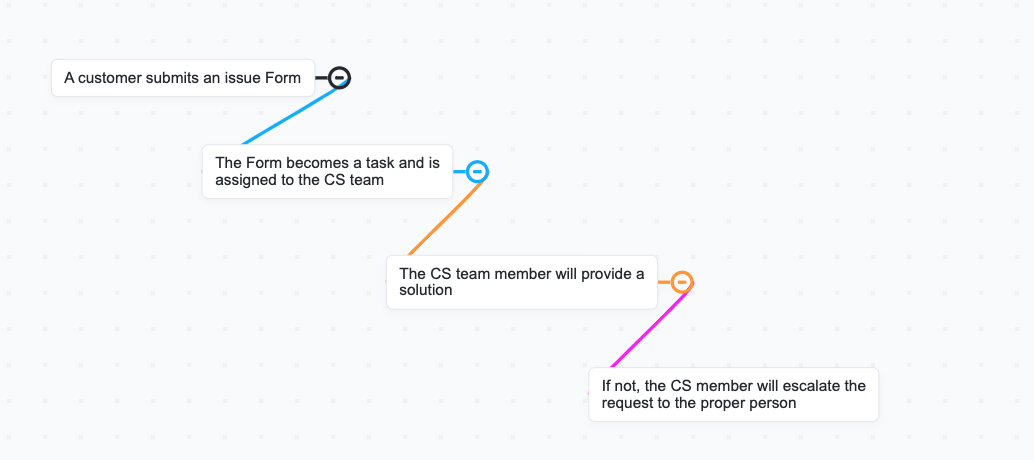
قم ببناء عملية الدعم الخاصة بك في أداة الخرائط الذهنية في ClickUp لتصور سير العمل بالكامل
خذ مثالاً على دعم تكنولوجيا المعلومات. ماذا يحدث إذا حددت أنه يجب على أي مدير فتح تذكرة دعم لفريق تكنولوجيا المعلومات لمنح التطبيق إمكانية الوصول إلى الموظفين الجدد؟ هذا صحيح! سيقاطع عدد أقل من المديرين فريق تكنولوجيا المعلومات بهذا النوع من الطلبات.
حل تبديل السياق: إنشاء القواعد والإجراءات
بعد ذلك، قم بتحديد قاعدة بالإطار الزمني لفريق تكنولوجيا المعلومات لمنح تذاكر الدخول إلى التطبيق. وفي تلك القاعدة، حدد، على سبيل المثال، أنه يجب على المديرين إنشاء تلك الطلبات قبل 30 يومًا من تاريخ قبول الموظف. وأخيراً، قم بإنشاء قائمة مهام تتضمن خطوات منح الوصول إلى التطبيقات المختلفة. وحدد أشكالاً مختلفة من هذا الإجراء لأدوار مختلفة.
تحقق من كليك أب قوالب سير العمل **_لإلغاء الانقطاعات التي لا تنتهي وحماية فريقك من تبديل السياق!
الالتزامات غير الضرورية
لقد مررنا جميعًا بهذا الموقف: محاولة التنقل في تقويم مليء بمكالمات الفيديو التي لم يكن من الضروري أن تحدث. لا يمكن لذاكرتنا العاملة أن تستوعب الكثير، ويمكن أن يؤدي تبديل السياق غير الضروري إلى تعطيلنا.
فكر في هذا أولاً - هل الاجتماع اختياري بالنسبة لدورك؟ إذا كان الأمر كذلك، فقم بتخطيه. خلاف ذلك، هل تحتاج إلى مدخلات وجهاً لوجه من شخص ما في ذلك الاجتماع؟ وإذا كان الأمر كذلك، هل يمكنك الاستمرار في عملك إذا لم تحصل على المدخلات في ذلك الوقت؟
إذا كانت الإجابة "لا"، هل تحتاج إلى رؤية ردود أفعال الناس على مدخلاتك مباشرة؟ هل تحتاج إلى التغلب على اعتراضاتهم؟ أو هل تتوقع أن يكون هناك الكثير من النقاش؟
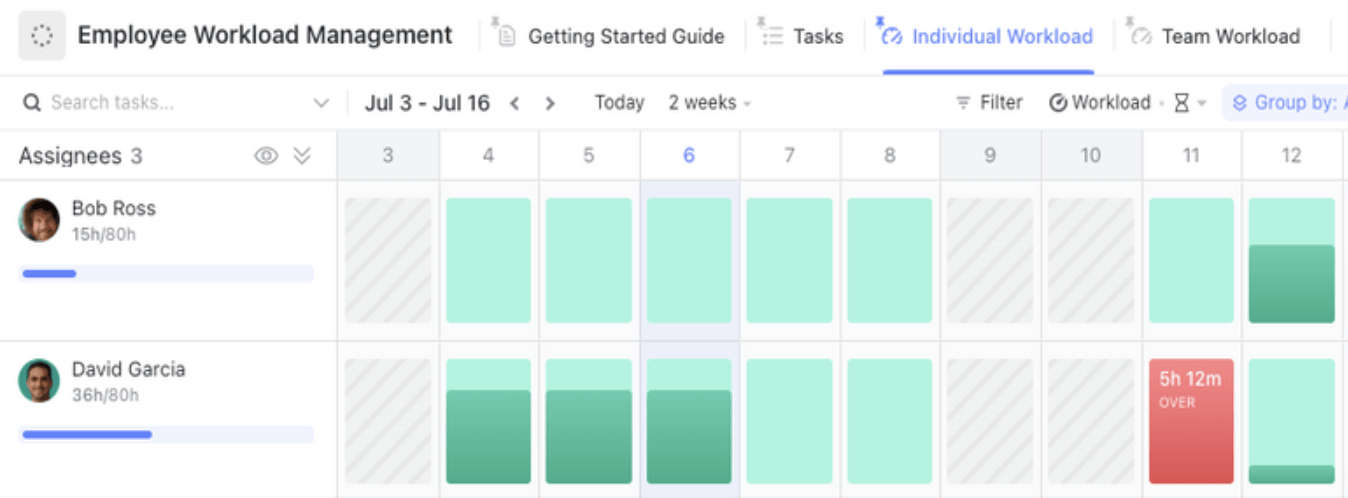
قم بالإشراف بسهولة على القدرات الأسبوعية لأعضاء الفريق باستخدام قالب إدارة عبء العمل للموظفين إدارة عبء العمل قالب بواسطة ClickUp
حل تبديل السياق #### تحديد أوقات المواعيد
حسناً، إذن، نصيحتنا هي تحديد أوقات المواعيد. ولكن يجب أن تكون انتقائيًا قبل قبول طلب الاجتماع التالي. وإذا كنت بحاجة ماسة لحضور عدة اجتماعات، فضع في اعتبارك أولويتها وحدد لكل منها اليوم والساعة المناسبين.
وبعد فترة وجيزة، قم بإعادة جدولة أو رفض الاجتماعات التي سترفع من سعر تبديل السياق دون داعٍ. بالإضافة إلى ذلك، احجز وقتًا للمهام التي يجب عليك القيام بها بمفردك أو بشكل منتظم وارفض الاجتماعات المجدولة لتلك الأوقات. هذه الجدولة الانضباط الذاتي سيساعدك على تنظيم عملك في عرض التقويم.
قم بجدولة المنشورات الاجتماعية، والمدونات، والإعلانات إلى جانب مهامك واجتماعاتك الأخرى باستخدام عرض التقويم في ClickUp
تقنيات متنوعة
إذا كنت تتحقق باستمرار من بريدك الإلكتروني، والرسائل الفورية، والإشعارات الفورية على الأجهزة المحمولة، فأنت تكثر من التبديل بين السياقات. تقرير صادر عن أدوبي أن الموظفين يتعرضون للمقاطعة 14 مرة تقريبًا في اليوم الواحد عن طريق البريد الإلكتروني وأدوات التعاون وأدوات المراسلة الفورية وإشعارات وسائل التواصل الاجتماعي.
حل تبديل السياق: تخصيص وقت لأدوات محددة
الآن، قد لا يمكنك القضاء على التدفق المستمر لرسائل البريد الإلكتروني والرسائل والإشعارات. ولكن يمكنك بالتأكيد التحكم في طريقة تأثيرها على عملك.
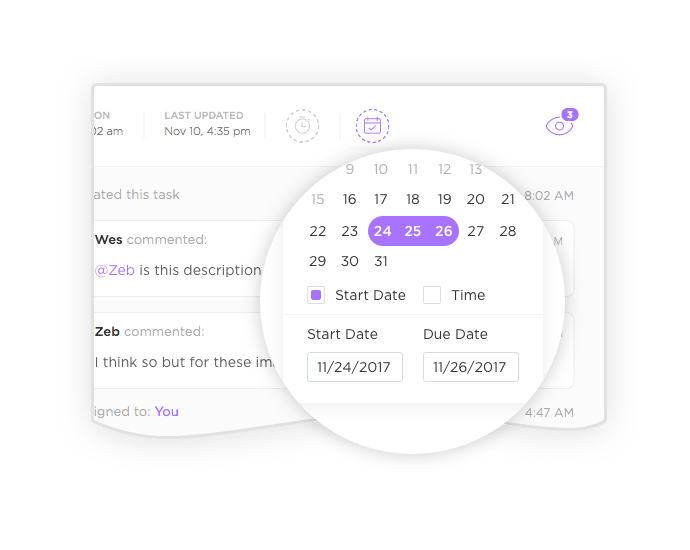
اختر متى يجب أن تبدأ المهمة حتى لا يتم تشتيت انتباهك بالمهام المفتوحة غير المنظمة
احجز أوقاتًا للتحقق من الطلبات الواردة والرد عليها وتجنب القيام بذلك خارج تلك الأوقات. خصص خانات مختلفة لأدوات أو تطبيقات أو أجهزة محمولة محددة مثل هاتفك الذكي. وقم بتهيئة تلك الخانات لتقليل تكاليف تبديل السياق مع عدم المساس بالتواصل في الوقت المناسب.
المهام غير المجمعة
إذا وجدت نفسك في كثير من الأحيان تتخلل المهام ذات الصلة بمهام أخرى، يجب أن تبدأ التجميع لهم. هذه طريقة رائعة لتجنب التبديل غير الضروري للسياق.
حل تبديل السياق: المهام ذات الصلة بالدفعات
يتكون تجميع المهام من تجميع المهام ذات الصلة لتقليل تكلفة تبديل السياق. ففي نهاية المطاف، يتمحور تبديل السياق حول التبديل بين المهام غير ذات الصلة، والحصول على أدوات إدارة المشروع لمساعدتك.
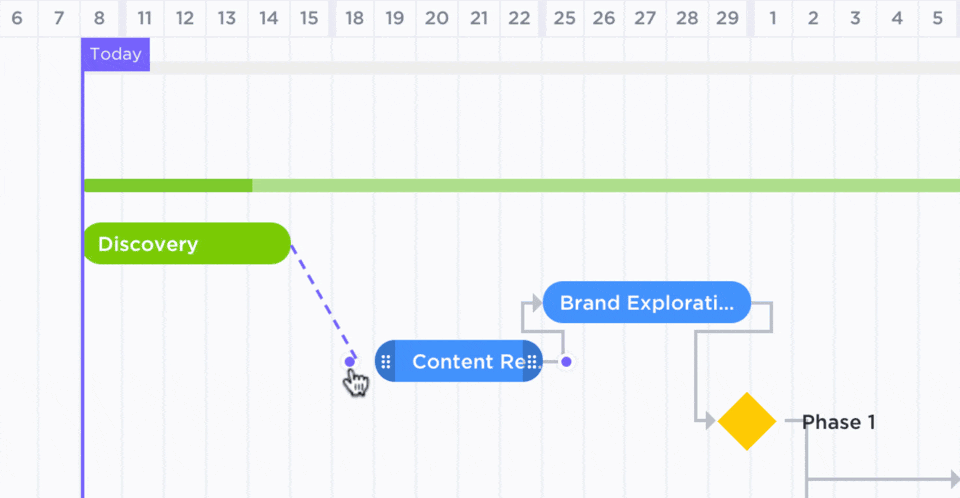
إظهار العلاقات بين مهمة واحدة ومهام متطلب رئيسي في عرض جانت في ClickUp
على سبيل المثال، تحليل مراجعات العملاء وتقارير خدمة العملاء هي مهام تطوير المنتج. وإذا كنت تضع خارطة طريق لمنتجك، فمن المنطقي تجميع تلك المهام المهمة.
ببساطة، فإن تجميع المهام يتوافق مع القيام بمهمة مرتبطة ببعضها البعض واحدة تلو الأخرى. وبالنسبة لحلول الدعم, تطبيقات بومودورو فعالة جدًا في مساعدة الموظفين في تحديد التركيز والحفاظ عليه من خلال مهمة واحدة أو العديد من المهام المتشابهة.
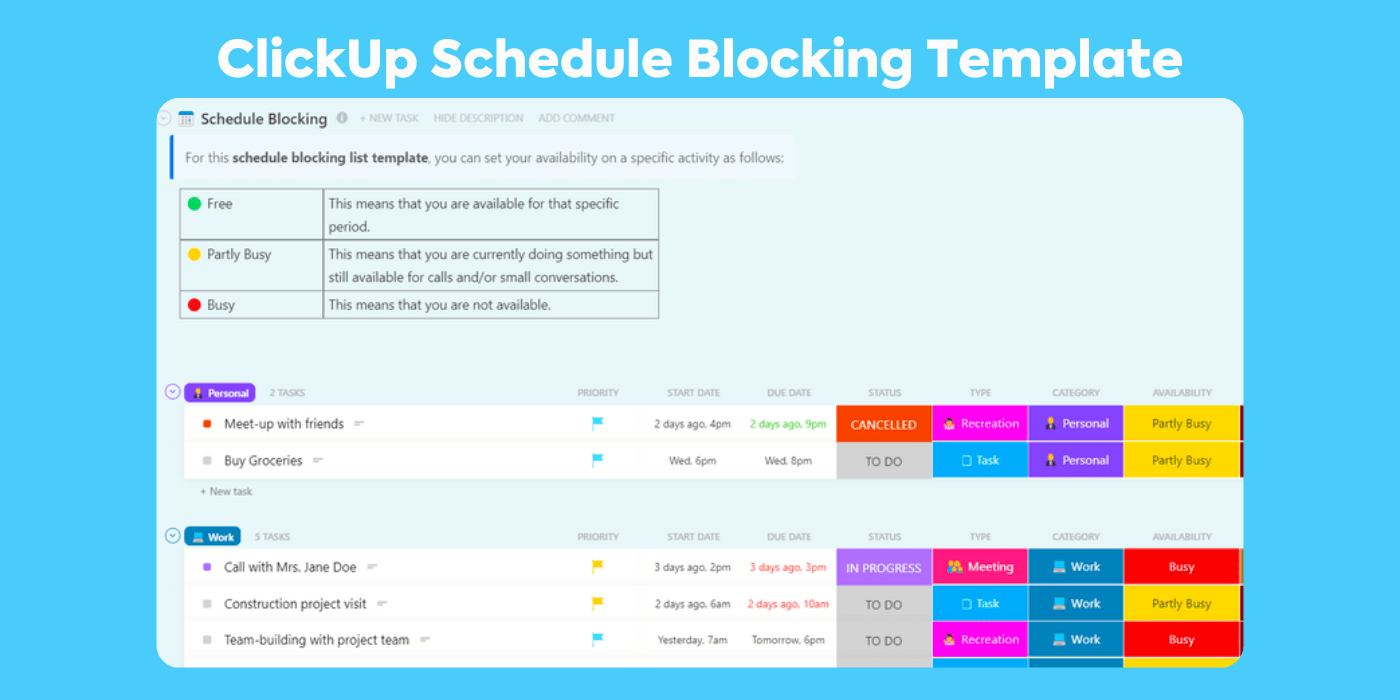
تتبع وقتك وجدولك الزمني بسهولة باستخدام قالب جدولة حظر الجدول الزمني من ClickUp حظر الوقت هي استراتيجية فعالة أخرى تعمل عن طريق حظر الوقت في جدولك الزمني لتجميع المهام المتشابهة للحصول على وقت أكثر إنتاجية في العمل. تنزيل هذا القالب نقرة واحدة لديها قوالب حظر الوقت **_لمساعدتك في الهروب من تكلفة تبديل السياق عن طريق تجميع المهام!
المهام المتتالية
هل تشعر أنه ليس لديك وقت للتنفس بين المهام المختلفة؟ إذن، يجب أن تقوم بتجميعها على مدار اليوم.
حل تبديل السياق: خذ استراحات
بقدر ما قد يبدو الأمر غير بديهي، فإن أخذ استراحات قصيرة بين المهام المختلفة (بما في ذلك الاجتماعات) يزيد من التركيز والإنتاجية. والطريقة الممتازة لعدم نسيان ذلك هي تهيئة التقويم الخاص بك بحيث تستثني مدة الحدث الافتراضية وقت الاستراحة.
10 طرق أخرى لتجنب تبديل السياق
- حدد تبديل السياق الخاص بك: تعرف على الوقت الذي تقوم فيه بالتبديل بين المهام وحدد الأولويات وفقًا لذلك.
- حدد أولوياتك: حدد المهام الأكثر أهمية وركز عليها أولاً.
- خصص وقتًا لمهامك: خصص فترات زمنية محددة لمهام محددة للحفاظ على تركيزك.
- خلق بيئة خالية من التشتيت: قلل من الضوضاء والفوضى والمقاطعات في مكان عملك.
- إدارة بريدك الإلكتروني بشكل استباقي: تحقق من بريدك الإلكتروني في أوقات محددة فقط لتجنب المقاطعات المستمرة.
- استخدم تقنيات إدارة الوقت: جرب أساليب مثل تقنية بومودورو للحفاظ على تركيزك على مهمة واحدة في كل مرة.
- قلل من مقاطعات زملائك في العمل: ضع حدودًا وأبلغهم بحاجتك لوقت عمل غير متقطع.
- قم بتوحيد الاجتماعات المتكررة: ضع جدولاً زمنيًا للاجتماعات معًا لتقليل الانقطاعات في العمل العميق.
- حدد جدولاً زمنياً للرسائل غير العاجلة: حدد أوقاتاً محددة للرد على الإشعارات والرسائل.
- مراجعة عوامل تشتيت الانتباه واستخدام أنظمة قائمة على المحفزات: تحديد عوامل تشتيت الانتباه وإزالتها، وتسجيل مقاطع فيديو للعمليات وتنفيذ أنظمة لتقليل التبديل بين السياقات.
مثال على تبديل السياق
دعنا نخبرك بقصة شركة Pharmacy Mentor وكيف ساعدناهم في تقليل تبديل السياق باستخدام ClickUp. موجه الصيدلة كان الموظفون مثقلين برسائل البريد الإلكتروني ويتبعون ممارسات غير متسقة في إدارة المشاريع. وبالتالي، كان التعامل مع عمليات عملائهم يمثل معاناة.
وكأن ذلك لم يكن مؤلماً بما فيه الكفاية، فقد كان درع التطبيقات التي يستخدمونها يولد تبديلات مستمرة في السياق. وكانت تكلفة كل عملية تبديل في السياق مرتفعة حتماً، وتأثرت الإنتاجية.
أدى توحيد أدوات إدارة المشاريع في Pharmacy Mentor إلى رفع مستويات التعاون في جميع أنحاء الشركة. فبدلاً من الاعتماد على أدوات إدارة علاقات العملاء الأقل إزعاجاً وTrillo وGoogle Docs وأداة للوحات البيضاء بشكل منفصل، اعتمدوا تطبيق ClickUp، والآن يتعاونون ضمن التذاكر بدلاً من عقد اجتماعات لا نهاية لها ورسائل البريد الإلكتروني والرسائل الفورية - وذلك لمكافحة تبديل السياق بشكل فعال.

تعاون مع العملاء أو الفرق الداخلية بفعالية أكبر باستخدام السبورات البيضاء الافتراضية لتحفيز الابتكار
وهكذا انقر فوق أصبحت منصة فارمسي مينتور منصة واحدة للتعاون مع حسابات العملاء والتواصل وإدارة المشاريع. وقد أتاح لهم ذلك إدارة العملاء بكفاءة أكبر وتقديم تجربة أفضل للعملاء - دون الحاجة إلى جميع التطبيقات المختلفة.
مع تكامل ClickUp ، ضاعف موجه الصيدلة إنتاجيتهم. كما أنها قللت من الأعمال المكررة بفضل أتمتة ClickUp والتذكيرات.
إلقاء نظرة على مدونتنا إذا كان لديك فضول لمعرفة المزيد عن أفضل عمليات تكامل ClickUp !
إدارة المهام المتعددة وتقليل التبديل بين السياقات باستخدام ClickUp
إذا كنت قد انتهيت من دفع ثمن تبديل السياق، فيجب عليك البحث في دمج الأدوات. ولدى ClickUp قائمة شاملة من عمليات الدمج الأصلية لهذا الغرض. قد تكون إدارة مهام متعددة أمراً صعباً، ولكن لا يجب أن يكون الأمر بهذه الطريقة.
قلل من التبديل بين السياقات بمساعدة إدارة مشروع ClickUp القوية و إدارة المهام الميزات. هل تريد أن ترى كيف يمكن لـ ClickUp تقليل التبديل غير الضروري بين السياقات بشكل أكبر وتوفير الكثير من الوقت على فريقك؟
قم بجدولة عرض توضيحي عند الطلب مع ClickUp!

